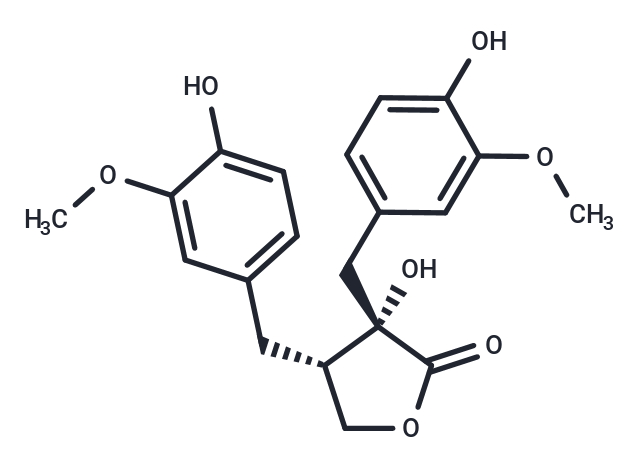Shopping Cart
- Remove All
 Your shopping cart is currently empty
Your shopping cart is currently empty
Nortrachelogenin ((-)-Wikstromol), which can be extracted from Partrinia scabiosaefolia, has antifungal activity and induces membrane disruption and cysteinyl asparagin-dependent apoptosis.

| Pack Size | Price | Availability | Quantity |
|---|---|---|---|
| 1 mg | $106 | In Stock | |
| 5 mg | $297 | In Stock | |
| 10 mg | $442 | In Stock | |
| 25 mg | $717 | In Stock | |
| 50 mg | $988 | In Stock | |
| 1 mL x 10 mM (in DMSO) | $288 | In Stock |
| Description | Nortrachelogenin ((-)-Wikstromol), which can be extracted from Partrinia scabiosaefolia, has antifungal activity and induces membrane disruption and cysteinyl asparagin-dependent apoptosis. |
| In vitro | Methanolic extract of the root bark of carissa edulis showed anti-plasmodial activity against the chloroquin-senitive (D6) strains of plasmodium falciparum parasite with an IC50 value of 1.95 Dg/ml. From this extract, a lignan compound Nortrachelogenin was isolated and showed anti-plasmodium activity of 14.50 Dg/ml. The structure was determined on the basis of spectroscopic evidence.[1] |
| Synonyms | (-)-Wikstromol, (-)-Nortrachelogenin |
| Molecular Weight | 374.38 |
| Formula | C20H22O7 |
| Cas No. | 34444-37-6 |
| Smiles | COc1cc(C[C@H]2COC(=O)[C@]2(O)Cc2ccc(O)c(OC)c2)ccc1O |
| Relative Density. | 1.370 g/cm3 (Predicted) |
| Storage | Powder: -20°C for 3 years | In solvent: -80°C for 1 year | Shipping with blue ice/Shipping at ambient temperature. | |||||||||||||||||||||||||||||||||||
| Solubility Information | DMSO: 55 mg/mL (146.91 mM), Sonication is recommended. | |||||||||||||||||||||||||||||||||||
Solution Preparation Table | ||||||||||||||||||||||||||||||||||||
DMSO
| ||||||||||||||||||||||||||||||||||||

Copyright © 2015-2025 TargetMol Chemicals Inc. All Rights Reserved.